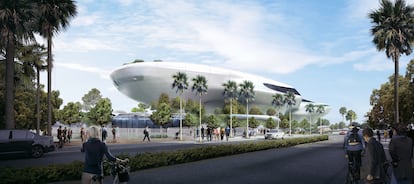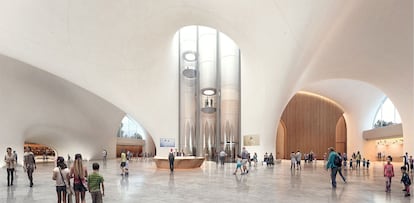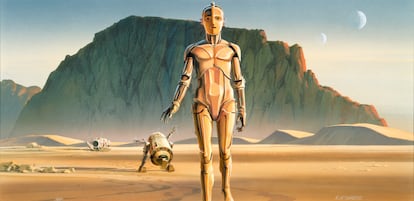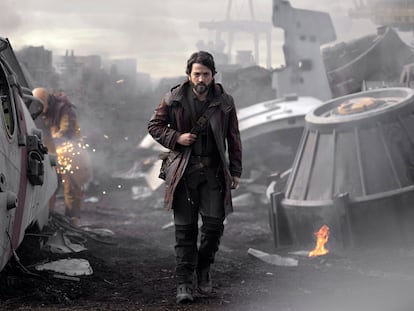George Lucas’s futuristic ark reveals its first mysteries
The creator of ‘Star Wars’ and ‘Indiana Jones’ opens the doors to the museum he is building in Los Angeles


In the south of Los Angeles, an imposing building has been rising over the city for five years. It stands directly in front of the Natural History Museum, an essential tourist stop in Exposition Park, where visitors can also see the space shuttle Endeavor. Starting in 2025, the great attraction of the area promises to be the Lucas Museum of Narrative Art.
The name of George Lucas, the creator of Star Wars and Indiana Jones who became a patron of art together with his wife, the financier Mellody Hobson, influences the viewer’s sense of the building. It is made up of a flattened sphere that is joined by a bridge to a huge oval, overlooking the University of Southern California – which the American Graffiti filmmaker attended. The museum’s grounds occupy almost four and a half hectares, and to many people it looks like a spaceship landed in its midst.
But the museum team is quick to refute the popular impression. “It’s the foliage of a tree,” said Sandra Jackson-Dumont, director and CEO of the institution, a few days ago to a group of journalists who visited the work, including EL PAÍS. Ma Yansong, the architect responsible for the design, was reportedly inspired by the tall trees in Exposition Park. His office, MAD Architects, proposed a huge pavilion that leads into a space designed to unite the community in this lower-middle-class residential area where 70% of residents are Black or Latino. To emphasize the botanical reference, the project foresees planting 200 trees throughout the area.

This week, workers began to put up the more than 1,500 curved fiberglass panels that will give the building a futuristic look. They have been specially manufactured in northern California by robots; 15% of the building’s roof is occupied by solar panels, which will help reduce the center’s environmental impact. Jackson-Dumont, who worked at the Met in New York for five years before coming to the West Coast, proudly noted that there is no single straight line on the façade of the Lucas Museum.
The idea for the museum was born in 2014. That year, Lucas and Hobson launched a competition to design a center that would be located in Chicago, where Hobson has great power thanks to the investment fund she chairs, Ariel, which has a budget of $16 billion. But a problem with the land forced the couple, who married in 2013, to look for a new location. They found it a few meters from the L.A. Coliseum, which has been the home of two Olympic Games and two Super Bowls.
After five years under construction and a $1 billion investment, the center has begun an aggressive public relations campaign to remind the public that the project did not fizzle out with the pandemic. It has simply been delayed once again. The opening date has been pushed back from 2022 to 2023 and now from 2023 to 2025. This week, the team held press events in Los Angeles and took part in a symposium in the Whitney Museum of New York with members of the art world to build buzz. In addition to the founders, the board of directors of the institution includes Henry Bienen, president emeritus of Northwestern University; sociologist Arne Duncan, who was Secretary of Education during the Obama Administration; Michael Govan, the director of the Los Angeles County Museum (LACMA); Andrea Wishom, the president of Skywalker Holdings, Lucas’s real estate company; and filmmakers Steven Spielberg and Guillermo del Toro.

The board has recently revealed some of the works that have been added to the catalog. Among them is a painting by Robert Colescott, a subversive painter whose work is full of sarcasm and irreverence. The canvas shows a black scientist George Washington Carver in the place of George Washington from Emanuel Leutze’s original painting crossing the Delaware. All those who appear in the painting are African American, a comment by Colescott on the absence of Black people in the historical landmarks of the United States.
The director of the museum believes that there will be no permanent galleries once the museum opens its doors. Her idea is that the works will be rotated within the museum. Before their marriage, Lucas and Hobson were already art collectors. She was mainly interested in works by African-American artists such as Norman Lewis and Kara Walker. Lucas’s forte was American art, graphics, comics and illustrations. After their union, they began looking for pieces that interested them both, such as canvases by the 1980s and 90s New York phenomenon Jean-Michel Basquiat, and the photorealistic works of Chuck Close.
A space dedicated to narrative art can sound confusing, and it is. The museum’s treasures include objects as disparate as pieces made 2,200 years ago in Egypt, mosaics from the Roman Empire, the post-war works of Normal Rockwell, African art, a replica of Velázquez’s “Las Meninas” made 200 years later by John Singer Sargent, photojournalism by Dorothea Lange, a self-portrait by Frida Kahlo, a mural by Judith Baca, Ralph McQuarrie’s art designs from the Star Wars movies and Marvel comics by Robert Crumb, star of the American underground cartoon.
“Our intention is to erase the borders between culture and popular art,” says the director. The museum will also have two exhibition halls with capacity for 300 people. One end of the building will include a library open to the public that will feature objects from the archive of Lucasfilm, the production company that the filmmaker sold to Disney in 2012 for $4 billion. The Museum also bought the Separate Cinema archive two years ago, which includes 37,000 objects linked to the history of Black film ranging from 1904 to 2019.
Tu suscripción se está usando en otro dispositivo
¿Quieres añadir otro usuario a tu suscripción?
Si continúas leyendo en este dispositivo, no se podrá leer en el otro.
FlechaTu suscripción se está usando en otro dispositivo y solo puedes acceder a EL PAÍS desde un dispositivo a la vez.
Si quieres compartir tu cuenta, cambia tu suscripción a la modalidad Premium, así podrás añadir otro usuario. Cada uno accederá con su propia cuenta de email, lo que os permitirá personalizar vuestra experiencia en EL PAÍS.
¿Tienes una suscripción de empresa? Accede aquí para contratar más cuentas.
En el caso de no saber quién está usando tu cuenta, te recomendamos cambiar tu contraseña aquí.
Si decides continuar compartiendo tu cuenta, este mensaje se mostrará en tu dispositivo y en el de la otra persona que está usando tu cuenta de forma indefinida, afectando a tu experiencia de lectura. Puedes consultar aquí los términos y condiciones de la suscripción digital.
More information
Últimas noticias
Most viewed
- Sinaloa Cartel war is taking its toll on Los Chapitos
- Oona Chaplin: ‘I told James Cameron that I was living in a treehouse and starting a permaculture project with a friend’
- Reinhard Genzel, Nobel laureate in physics: ‘One-minute videos will never give you the truth’
- Why the price of coffee has skyrocketed: from Brazilian plantations to specialty coffee houses
- Silver prices are going crazy: This is what’s fueling the rally









































